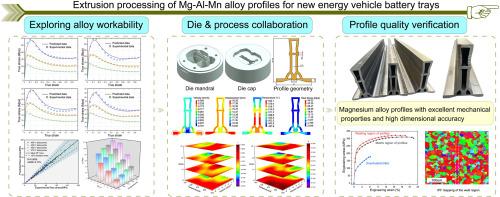Mg–Al–Mn magnesium alloy processability and its extrusion simulation of complex profiles for automotive battery trays
IF 6.6
2区 材料科学
Q1 MATERIALS SCIENCE, MULTIDISCIPLINARY
Journal of Materials Research and Technology-Jmr&t
Pub Date : 2025-09-16
DOI:10.1016/j.jmrt.2025.09.122
引用次数: 0
Abstract
Although magnesium alloy thin-walled profiles possess significant lightweight potential for new energy vehicle battery trays, their processing has not been reported previously. This study systematically investigates the workability of an Mg-7.5Al-0.5Mn-0.3Ce alloy (a novel composition specifically designed for lightweight battery tray applications) and its extrusion process. Hot compression tests are performed to characterize the rheological behavior, resulting in the development of a strain-compensated Arrhenius-type constitutive model incorporating Zener-Hollomon parameters. The model demonstrates excellent predictive capability, with a correlation coefficient (R) of 0.9938 and an average absolute relative error (AARE) of 3.73%. The combination of this Arrhenius model with processing maps identifies an optimal processing window (approximately 723 K at low strain rates with power dissipation efficiency η >0.3), providing theoretical guidance for hot deformation process optimization. The use of custom-designed planar manifold combination dies, integrated with HyperXtrude numerical simulation, achieves uniform material flow at the profile outlet (maximum velocity difference: 0.5 mm/s). Experimental validation shows a close agreement between simulation and experimental extrusion results. Microstructural characterization confirms complete grain fusion in the weld seam with no detectable surface coarse grains. Mechanical tests demonstrate superior properties in the weld zone (tensile strength: 321.9 MPa) compared to the base material (310.6 MPa). These findings validate the optimized manifold die extrusion parameters, enabling high-quality forming of thin-walled profiles with large width-to-thickness ratios. This work provides a technical foundation for magnesium alloy applications in new-energy vehicle battery trays.

汽车电池托盘复合型材Mg-Al-Mn镁合金可加工性及其挤压模拟
尽管镁合金薄壁型材在新能源汽车电池托盘中具有显著的轻量化潜力,但其加工尚未见报道。本研究系统地研究了Mg-7.5Al-0.5Mn-0.3Ce合金(一种专门为轻型电池托盘应用而设计的新型成分)的可加工性及其挤压工艺。进行热压缩试验以表征流变行为,从而开发了包含Zener-Hollomon参数的应变补偿arrhenius型本构模型。模型具有良好的预测能力,相关系数(R)为0.9938,平均绝对相对误差(AARE)为3.73%。将Arrhenius模型与加工图相结合,确定了最佳加工窗口(低应变率下723 K左右,功率耗散效率η >;0.3),为热变形工艺优化提供了理论指导。采用定制设计的平面流形组合模具,结合HyperXtrude数值模拟,在型材出口实现均匀的物料流动(最大速度差:0.5 mm/s)。实验验证表明,模拟结果与实验结果吻合较好。显微组织表征证实焊缝中完全的晶粒融合,没有检测到表面的粗晶粒。力学试验表明,与母材(310.6 MPa)相比,焊接区性能优越(抗拉强度:321.9 MPa)。这些发现验证了优化的流形模具挤压参数,实现了高质量的薄壁型材成型与大的宽厚比。为镁合金在新能源汽车电池托盘中的应用提供了技术基础。
本文章由计算机程序翻译,如有差异,请以英文原文为准。
求助全文
约1分钟内获得全文
求助全文
来源期刊

Journal of Materials Research and Technology-Jmr&t
Materials Science-Metals and Alloys
CiteScore
8.80
自引率
9.40%
发文量
1877
审稿时长
35 days
期刊介绍:
The Journal of Materials Research and Technology is a publication of ABM - Brazilian Metallurgical, Materials and Mining Association - and publishes four issues per year also with a free version online (www.jmrt.com.br). The journal provides an international medium for the publication of theoretical and experimental studies related to Metallurgy, Materials and Minerals research and technology. Appropriate submissions to the Journal of Materials Research and Technology should include scientific and/or engineering factors which affect processes and products in the Metallurgy, Materials and Mining areas.
 求助内容:
求助内容: 应助结果提醒方式:
应助结果提醒方式:


